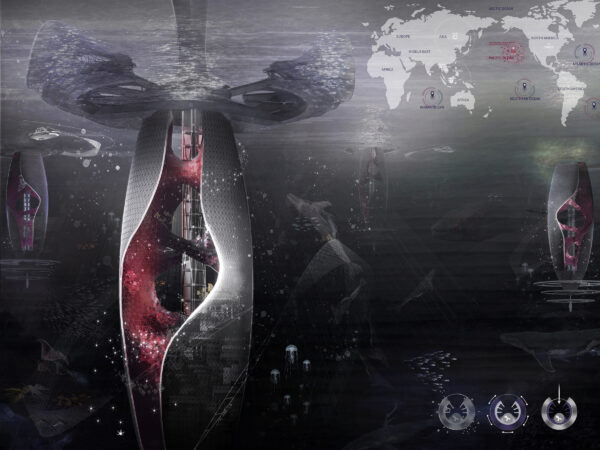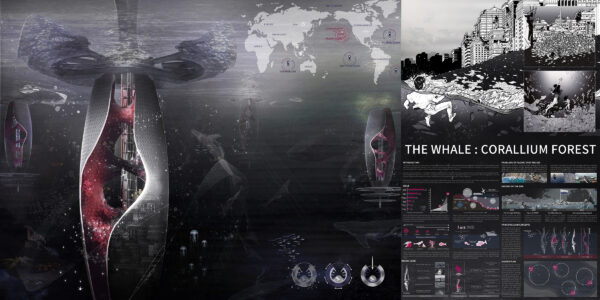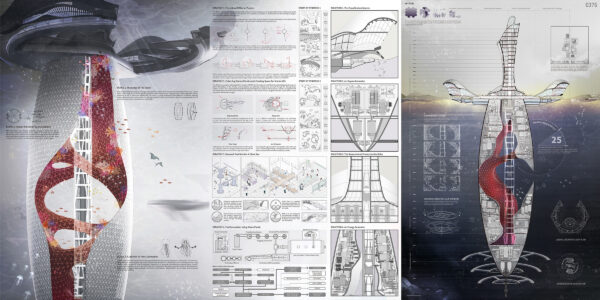Honorable Mention
2023 Skyscraper Competition
Jihyo Kim, Hyunhee Lee, Seungho Woo, Gyeonghyeon Choi, Yewon Jo
South Korea
Today, plastic pollution exists everywhere in the world, and pollution are increasing exponentially. Plastic began to be widely used only after World War II, but the total mass of plastic produced so far has already exceeded twice the total mass of all animals combined. Plastic production has skyrocketed over the past two decades, with plastic produced from 2003 to 2016 being as much as all the plastics produced earlier. Also, a significant portion of it has been introduced into the oceans, with about 150 million tons of plastic accumulated in the oceans. At this point, some systematic global changes for the marine plastics are desperately needed.
Marine plastics tend to converge at the center of the reflux zone with less seawater flow, so water pollution will be concentrated. Therefore, we set up the largest reflux zone, GPGP, as a site, with the idea of solving the problem around the reflux zone where numerous plastics gather on the sea. The Whale is expected to remove them effectively for it always takes the ocean current into consideration.
The methods of collecting marine plastics are divided into two largely, above-ground and underground areas. On the ground, there is a ‘Saving Ocean System’ that creates a U-shaped artificial coastline to collect garbage at sea level. And there is a ‘Surrounding Cleaner’ that collects plastics nearby and ones from artificial air-bubbles. At the underground, R.jellyfish and R.fish that collect long-distance plastic are activated. In addition, the ‘A.C.E System’, located at the bottom, purifies micro-plastics in close range.
The garbage collected in this way can be used as an energy source to run the entire building. Marine plastics delivered through the ground section pass through the ‘Pre-Classification System’ and will be classified according to certain types and moved to the underground machine room. Among the classified plastics, non-recyclable plastics will be crushed, up-cyclable plastics will be stored in storage, and the rest will be gasified to be used as energy in the building.
However, it’s important to reduce plastic emission by targeting the causes of its occurrence as well as to remove the plastic out there. We’ll invest sufficiently in research facilities for leading upcycle companies, institutions that promotes plastic-zero campaigns, WWF and so on. Moreover, as a huge skyscraper, it’s possible to inform people of the dangers of marine plastic.
Our ultimate goal is to transform a destroyed marine ecosystem into a pleasant one for marine creatures. ‘The lungs of the ocean’ located in the building, provides a lot of oxygen like its name to create great environment for various creatures to live in. The filter panel and the air bubble barrier prevent microplastics from entering it, and the oxygen generator ensures smooth oxygen supply. The outer surface with corals is harmonized with marine creatures so they can come and go naturally. It’s the only place where they can breathe comfortably in this seriously destroyed marine ecosystem, and is a true resting place for marine life. That place will later become a part of the nature.
We may start with constructing 4Whales in the GPGP, but the Whale can exist anywhere where polluted with marine wastes not just in the giant reflux zone. The marine plastic removal through the Whale and the increase in research facilities for environmental improve will result in protecting the ocean ravaged by harmful substances from plastics, and creating a positive ecological room for marine life to rest unbothered. Our effort to bring back nature that has been damaged by mankind made the Whale. We’re sure that it will be a skyscraper that enables positive changes for the better marine ecosystem.

















